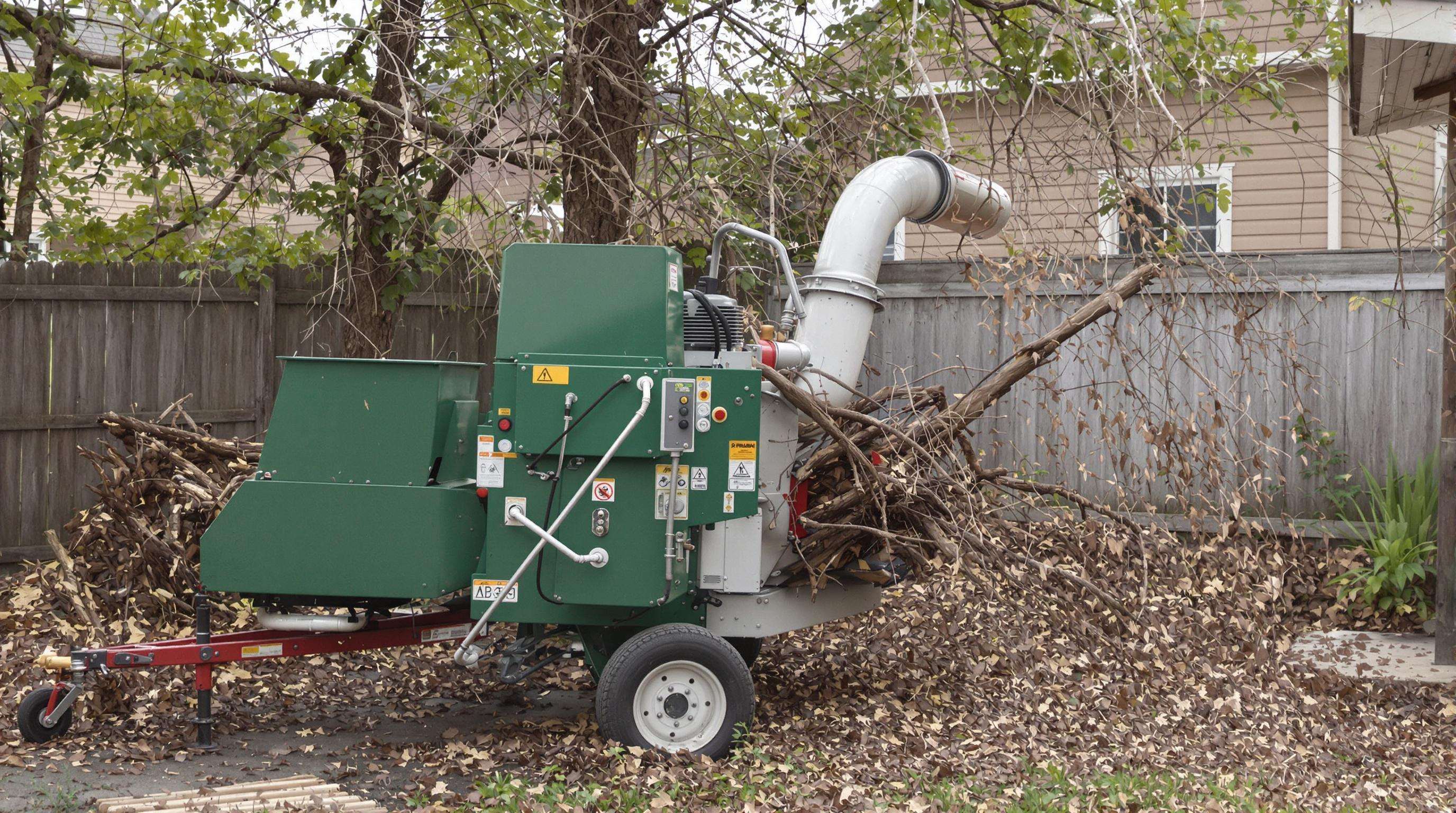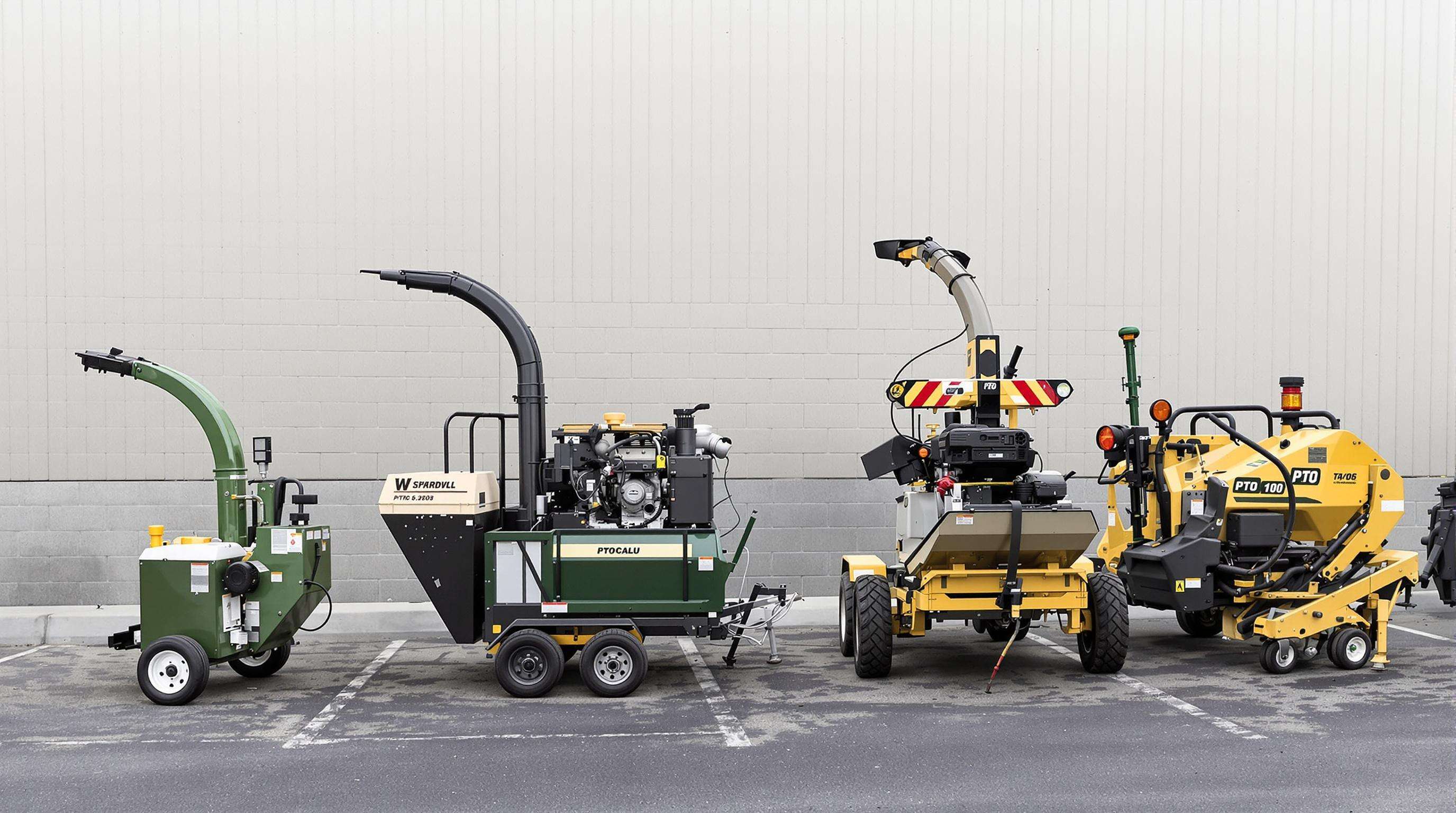Branch Shredder Basics: Definition and Core Functionality

A branch shredder (also known as a wood chipper or chipper shredder) reduces larger organic waste to small chips or mulch by means of a mechanical cutting device. This machinery inputs branches through an infeed hopper where a rotating blade or flail inside quickly processes materials. The heart of the system is the ability to process the waste, which is where the volume is reduced of the bagged/garden waste and turned into a size more suitable for composting or covering ground.
Two primary mechanisms drive this process:
- Chippers: Use hardened steel blades on a rotating flywheel to slice clean wood into uniform chips.
- Shredders: Employ hammer-like flails to pulverize leafy material into finer mulch.
Most modern models integrate both functions as multi-purpose units, making them indispensable for converting yard waste into valuable landscaping resources while optimizing disposal efficiency.
4 Types of Branch Shredders Compared

Electric vs Gas-Powered: Noise and Maintenance Tradeoffs
Electric branch shredders are under 85 decibels (quieter than most conversations) and have little to no maintenance outside of the few times a year when youll clean the blade. Gas models produce from 90-110 dB (similar to chainsaws) and require regular scheduled oil changes and air filter changes. But they provide 3X more torque than comparative electric models capable of tackling tough hardwoods 4 in dimension. When you're working in the city us type prefer electric to keep the noisemakers off your back, but when you're out in the countryside looking for all the power you can get, you'll find that gas is your thing.
Drum vs Disc Cutting Mechanisms: Output Size Differences
Disc chippers use high-speed blades (200-450 RPM) to shear branches under 1.4 inches into fine mulch ideal for composting. Drum systems crush wood at 4,000 RPM, processing 2-3 inch limbs into coarse chips better suited for pathway coverage.
Portable vs PTO-Driven Models for Landscaping vs Farm Use
Self-contained portable shredders weigh under 100 pounds, fitting pickup beds for neighborhood cleanup. PTO (Power Take-Off) models attach directly to tractors, leveraging diesel horsepower to process 5+ cubic yards hourly. Landscapers benefit from portability, while farmers rely on PTO systems for continuous throughput in fence-line clearing and orchard maintenance.
Industrial vs Residential Capacity Requirements
Residential shredders handle branches 3 inches with 0.5-1 cubic yard hourly output. Industrial chippers feature hydraulic feed rollers and auto-reversing mechanisms to process 4-8 inch logs nonstop, achieving 10+ cubic yards hourly for municipal operations.
Key Selection Criteria for Branch Shredder Buyers
Matching Chipper Size to Your Typical Branch Diameter
Choose a shredder with a branch diameter capacity exceeding your regular debris. Classifications include:
- Light-duty (¦2" diameter): Handles softwoods and seasonal pruning.
- Medium-duty (2"-4"): Processes dense deciduous branches.
- Heavy-duty (>4"): Recommends worm-screw mechanisms for logs up to 6".
Measure your largest common branches before purchaseexceeding manufacturer capacities risks blade damage or safety hazards.
Fuel Efficiency vs Power: The 3:1 Gas-to-Electric Torque Ratio
Gasoline models deliver 3x higher torque than comparable electric units (80Nm vs. 25Nm) but consume 30% more energy/hour and emit louder noise (90dB vs. 75dB). Opt for electric for properties under 1 acre or infrequent use; choose gas for larger properties or professional landscaping.
Throughput Needs: Cubic Yards Per Hour Calculations
Estimate hourly processing needs using:(Monthly Debris Volume) · (Available Monthly Shredding Hours)
For example, a property generating 12 cubic yards monthly with 16 hours available requires a 0.75 yd³/hour minimum capacity. Select equipment exceeding your peak seasonal volume by 20% to avoid backlog.
Safety Protocols for Branch Shredder Operation
Proper Feeding Techniques to Prevent Kickback Accidents
Feed branches butt-first into the infeed chute at full RPM, using long-handled push tools instead of hands. Stand perpendicular to the chute opening to avoid direct projectile paths. Sequential feeding prevents overloads, reducing jam risks by 40% (OSHA 2023).
PPE Requirements: OSHA-Recommended Protection Gear
Operators must wear ANSI-approved safety goggles, cut-resistant gloves, ear protection for environments over 85 dB, reinforced steel-toe boots, and close-fitting clothing. Proper PPE implementation lowers injury severity by 65% in material processing accidents.
Maintenance Practices for Optimal Branch Shredder Longevity
Blade Sharpening Frequency Based on Usage Intensity
- Light residential use (<5 hours weekly): Sharpen every 3 months.
- Moderate operations (1-2 yd³/hour): Monthly attention.
- Heavy-duty commercial use (>25 hours weekly): Bi-weekly maintenance.
Watch for increased vibration, ragged chips, or slower processing timesall signs of dull blades.
Winterization Steps for Gas-Powered Units
Before storage:
- Drain gasoline or add stabilizer.
- Run the engine until dry to eliminate residual fuel.
- Remove the spark plug and inject fogging oil into the cylinder.
-
Seal air intakes/exhausts against moisture.
Store in a dry, temperature-controlled space (avoid direct tarp contact with metal).
Choosing Your First Branch Shredder: Application-First Approach
Urban Yard Care vs Rural Land Clearing: Feature Priorities
Urban users should focus on compact, low-noise electric shredders (<2" capacity, <85 dB). Rural operators need gas-powered or PTO-driven units with 4+" branch capacity, prioritizing torque and mobility.
Total Cost Analysis: Upfront Price vs 5-Year Maintenance
Budget electric models ($300-$800) may save initially but incur $80-$120 yearly in blade replacements. Mid-tier gas shredders ($1,500+) cost $150-$300 annually for fuel and maintenance, while premium PTO units ($3,500+) offer lower per-hour costs over five years for frequent users. Balance volume needs against lifecycle expenses.
FAQs About Branch Shredders
What is a branch shredder used for?
A branch shredder is used to reduce large organic waste such as branches and garden waste into small chips or mulch suitable for composting or ground covering.
How do I choose the right branch shredder?
Choose a branch shredder based on branch diameter capacity, power source (electric vs gas), and the amount of debris you typically process. Consider noise levels, maintenance needs, and whether it’s for residential or industrial use.
Why are some branch shredders electric while others are gas-powered?
Electric shredders are quieter and require less maintenance, making them ideal for smaller properties or urban settings. Gas-powered models offer more power and are better suited for larger properties or commercial use.
What maintenance practices should I follow for my shredder?
Regularly sharpen blades, especially if used frequently. Winterize gas-powered units by draining fuel and adding stabilizers before storage. Follow the manufacturer's guidelines for maintenance.
Table of Contents
- Branch Shredder Basics: Definition and Core Functionality
- 4 Types of Branch Shredders Compared
- Key Selection Criteria for Branch Shredder Buyers
- Safety Protocols for Branch Shredder Operation
- Maintenance Practices for Optimal Branch Shredder Longevity
- Choosing Your First Branch Shredder: Application-First Approach
- FAQs About Branch Shredders

